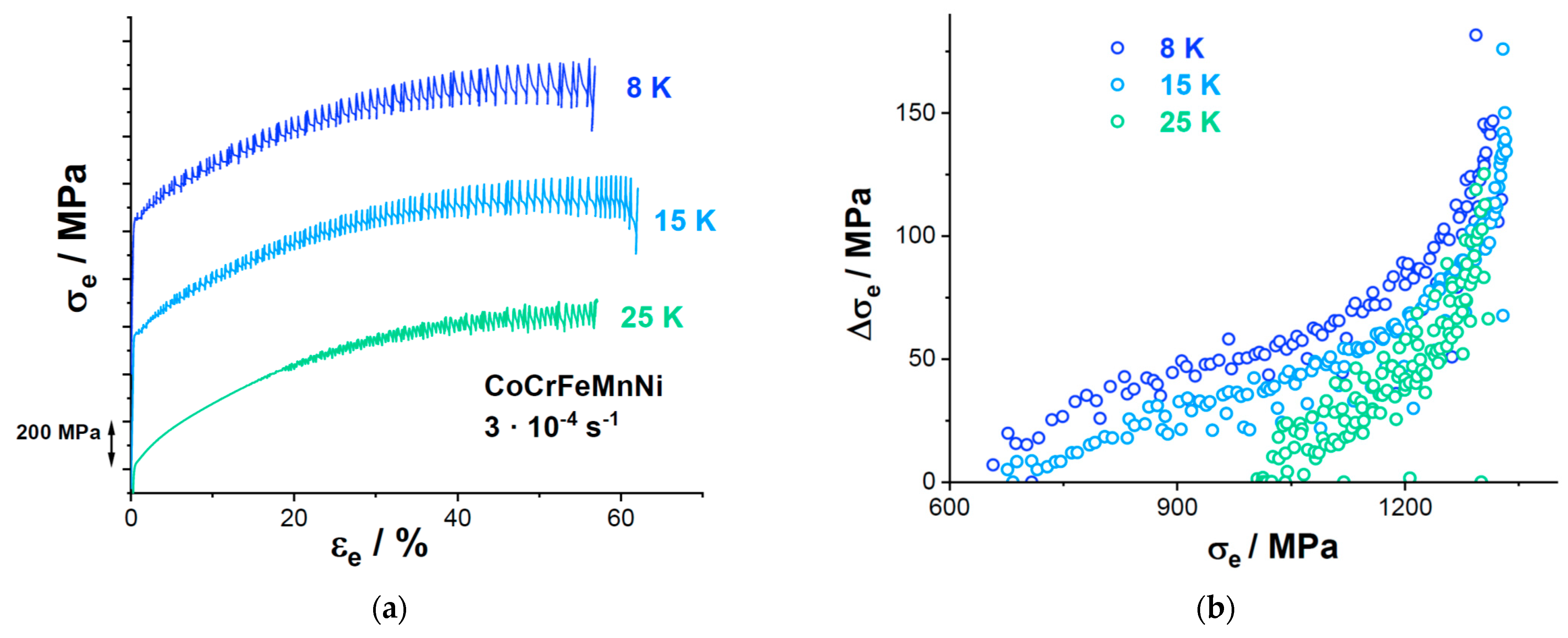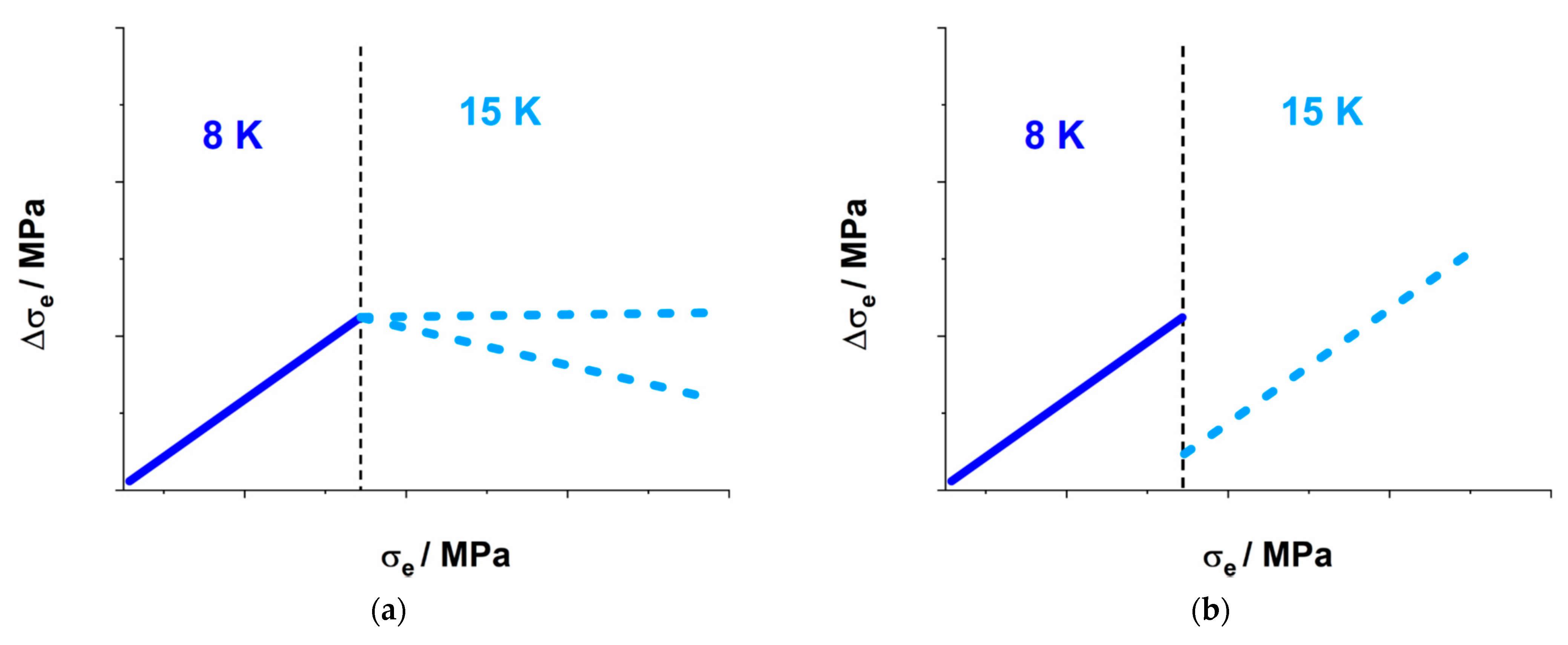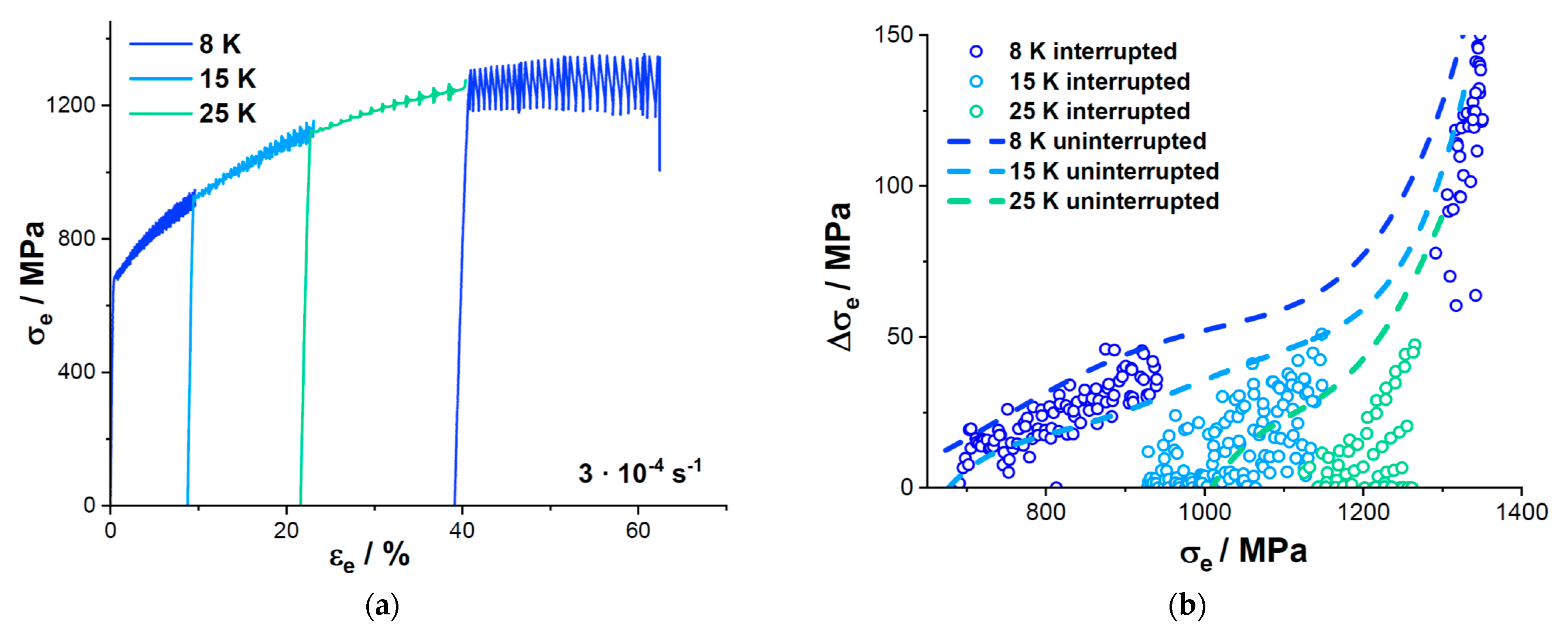Revealing the Role of Cross Slip for Serrated Plastic Deformation in Concentrated Solid Solutions at Cryogenic Temperatures
Abstract
:1. Introduction
2. Materials and Methods
3. Results and Discussion
3.1. Tensile Tests up to Fracture Model Considerations
3.2. Expectations on Interrupted Tests from the Different Models
3.3. Results of the Interrupted Tests
4. Conclusions
Author Contributions
Funding
Data Availability Statement
Acknowledgments
Conflicts of Interest
References
- Zhang, Y.; Liu, J.P.; Chen, S.Y.; Xie, X.; Liaw, P.K.; Dahmen, K.A.; Qiao, J.W.; Wang, Y.L. Serration and noise behavior in materials. Prog. Mater. Sci. 2017, 90, 358–460. [Google Scholar] [CrossRef]
- Pustovalov, V.V. Serrated deformation of metals and alloys at low temperatures (Review). Low Temp. Phys. 2008, 34, 683–723. [Google Scholar] [CrossRef]
- Cottrell, A.H. LXXXVI. A note on the Portevin-Le Chatelier effect. Lond. Edinb. Dublin Philos. Mag. J. Sci. 1953, 44, 829–832. [Google Scholar] [CrossRef]
- Lebyodkin, M.A.; Lebedkina, T.A.; Brechtl, J.; Liaw, P.K. Serrated Flow in Alloy Systems. In High-Entropy Materials: Theory, Experiments, and Applications; Brechtl, J., Liaw, P.K., Eds.; Springer: Cham, Switzerland, 2021; pp. 523–644. [Google Scholar] [CrossRef]
- Tirunilai, A.S.; Sas, J.; Weiss, K.-P.; Chen, H.; Szabó, D.V.; Schlabach, S.; Haas, S.; Geissler, D.; Freudenberger, J.; Heilmaier, M.; et al. Peculiarities of deformation of CoCrFeMnNi at cryogenic temperatures. J. Mater. Res. 2018, 33, 3287–3300. [Google Scholar] [CrossRef] [Green Version]
- Tirunilai, A.S.; Hanemann, T.; Weiss, K.-P.; Freudenberger, J.; Heilmaier, M.; Kauffmann, A. Dislocation-based serrated plastic flow of high entropy alloys at cryogenic temperatures. Acta Mater. 2020, 200, 980–991. [Google Scholar] [CrossRef]
- Naeem, M.; He, H.; Harjo, S.; Kawasaki, T.; Lin, W.; Kai, J.-J.; Wu, Z.; Lan, S.; Wang, X.-L. Temperature-dependent hardening contributions in CrFeCoNi high-entropy alloy. Acta Mater. 2021, 221, 117371. [Google Scholar] [CrossRef]
- Naeem, M.; He, H.; Zhang, F.; Huang, H.; Harjo, S.; Kawasaki, T.; Wang, B.; Lan, S.; Wu, Z.; Wang, F.; et al. Cooperative deformation in high-entropy alloys at ultralow temperatures. Sci. Adv. 2020, 6, eaax4002. [Google Scholar] [CrossRef] [PubMed] [Green Version]
- Basinski, Z.S. The instability of plastic flow of metals at very low temperatures. Proc. R. Soc. A 1957, 240, 354–358. [Google Scholar] [CrossRef]
- Seeger, A. The mechanism of glide and work hardening in Face-Centered Cubic and Hexagonal-Close Packed metals. In Dislocations and Mechanical Properties of Crystals; Fisher, J.C., Ed.; John Wiley & Sons, Inc.: New York, NY, USA, 1958; pp. 243–330. [Google Scholar]
- Han, W.; Liu, Y.; Wan, F.; Liu, P.; Yi, X.; Zhan, Q.; Morrall, D.; Ohnuki, S. Deformation behavior of austenitic stainless steel at deep cryogenic temperatures. J. Nuclear Mater. 2018, 504, 29–32. [Google Scholar] [CrossRef]
- Seeger, A. CXXXII. The generation of lattice defects by moving dislocations, and its application to the temperature dependence of the flow-stress of F.C.C. crystals. Lond. Edinb. Dublin Philos. Mag. J. Sci. 1955, 46, 1194–1217. [Google Scholar] [CrossRef]
- Hirth, J.P.; Lothe, J. Glide of jogged dislocations. In Theory of Dislocations; McGraw-Hill Book Company: New York, NY, USA; St. Louis, MO, USA; San Francisco, CA, USA; Toronto, ON, Canada; London, UK; Sydney, Australia, 1968; pp. 535–556. [Google Scholar]
- Obst, B.; Nyilas, A. Experimental evidence on the dislocation mechanism of serrated yielding in f.c.c. metals and alloys at low temperatures. Mater. Sci. Eng. A 1991, 137, 141–151. [Google Scholar] [CrossRef]
- Skoczeń, B.; Bielski, J.; Sgobba, S.; Marcinek, D. Constitutive model of discontinuous plastic flow at cryogenic temperatures. Int. J. Plast. 2010, 26, 1659–1679. [Google Scholar] [CrossRef]
- Tirunilai, A.S.; Hanemann, T.; Reinhart, C.; Tschan, V.; Weiss, K.-P.; Laplanche, G.; Freudenberger, J.; Heilmaier, M.; Kauffmann, A. Comparison of cryogenic deformation of the concentrated solid solutions CoCrFeMnNi, CoCrNi and CoNi. Mater. Sci. Eng. A 2020, 783, 139290. [Google Scholar] [CrossRef]
- Sas, J.; Weiss, K.-P.; Bagrets, N. Cryomak—The overview of cryogenic testing facilities in Karlsruhe. Acta Metall. Slovaca 2015, 21, 330–338. [Google Scholar] [CrossRef] [Green Version]



Publisher’s Note: MDPI stays neutral with regard to jurisdictional claims in published maps and institutional affiliations. |
© 2022 by the authors. Licensee MDPI, Basel, Switzerland. This article is an open access article distributed under the terms and conditions of the Creative Commons Attribution (CC BY) license (https://creativecommons.org/licenses/by/4.0/).
Share and Cite
Tirunilai, A.S.; Weiss, K.-P.; Freudenberger, J.; Heilmaier, M.; Kauffmann, A. Revealing the Role of Cross Slip for Serrated Plastic Deformation in Concentrated Solid Solutions at Cryogenic Temperatures. Metals 2022, 12, 514. https://doi.org/10.3390/met12030514
Tirunilai AS, Weiss K-P, Freudenberger J, Heilmaier M, Kauffmann A. Revealing the Role of Cross Slip for Serrated Plastic Deformation in Concentrated Solid Solutions at Cryogenic Temperatures. Metals. 2022; 12(3):514. https://doi.org/10.3390/met12030514
Chicago/Turabian StyleTirunilai, Aditya Srinivasan, Klaus-Peter Weiss, Jens Freudenberger, Martin Heilmaier, and Alexander Kauffmann. 2022. "Revealing the Role of Cross Slip for Serrated Plastic Deformation in Concentrated Solid Solutions at Cryogenic Temperatures" Metals 12, no. 3: 514. https://doi.org/10.3390/met12030514
APA StyleTirunilai, A. S., Weiss, K.-P., Freudenberger, J., Heilmaier, M., & Kauffmann, A. (2022). Revealing the Role of Cross Slip for Serrated Plastic Deformation in Concentrated Solid Solutions at Cryogenic Temperatures. Metals, 12(3), 514. https://doi.org/10.3390/met12030514







